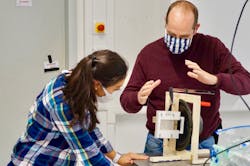A new device that could make a difference for ultrahigh-speed wireless communications has been created by researchers at Philipps-Universität Marburg (Germany) and Centro de Investigaciones en Óptica, A.C. (León, Mexico). Using 3D printing, the researchers constructed and demonstrated a plastic structure that can be used to redirect terahertz radiation to specific targets, such as laptops, tablets, and mobile phones, allowing it to individually address them for data transfer. This opens the possibility of operating short-range data networks with terahertz radiation instead of microwaves, potentially increasing the speed of Wi-Fi networks by hundreds of times while increasing the security of such communications.
A reflective diffraction grating is formed from a 1D array of 17 plastic strips 50 mm long and 0.8 mm wide covered with aluminum foil and connected by V-shaped springs; the array period is 2.3 mm when relaxed and can be continuously reduced to 1.1 mm by applying lateral pressure to the array. A 3D-printed vice mount holds the adjustable grating and applies pressure as needed. Tests at frequencies of 0.1 to 1 THz showed the device’s usefulness for steering a terahertz beam though angles of 25° or greater. In another experiment, the device was driven by a speaker for faster beam-steering. The plastic assembly can be mass-produced at extremely low costs and, after further development, could become a standard component in future Wi-Fi or other short-range communications systems. Reference: J. M. Seifert et al., Opt. Express, 28, 21737 (2020); https://doi.org/10.1364/oe.399376.

John Wallace | Senior Technical Editor (1998-2022)
John Wallace was with Laser Focus World for nearly 25 years, retiring in late June 2022. He obtained a bachelor's degree in mechanical engineering and physics at Rutgers University and a master's in optical engineering at the University of Rochester. Before becoming an editor, John worked as an engineer at RCA, Exxon, Eastman Kodak, and GCA Corporation.
